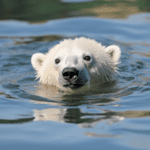
Introduction: Polar bears, often referred to as the “Kings of the Arctic,” are one of the most iconic and magnificent creatures on our planet. These awe-inspiring animals are known for their impressive size, icy habitat, and incredible adaptations to survive in one of the harshest environments on Earth. Beyond the usual facts you might know, there are some truly odd and fascinating details about polar bears that showcase their unique biology and behaviors. In this article, we’ll explore 10 odd but true facts about these incredible creatures.
- Black Skin, Transparent Fur: Despite their seemingly white appearance, a polar bear’s skin is actually black. This dark skin helps them absorb and retain heat from the sun, essential for survival in the cold Arctic climate. Their fur, however, is translucent rather than white. Each hair strand is hollow and reflects light, giving polar bears their characteristic white appearance.
- Excellent Swimmers: Polar bears are powerful swimmers and can cover impressive distances in the water. They are known to swim hundreds of miles between ice floes in search of prey. Their strong front paws serve as paddles, and their hind legs act as rudders, enabling them to navigate through icy waters efficiently.
- Unique Liver Adaptations: Polar bears have unique liver adaptations that allow them to process large amounts of Vitamin A, which they obtain from consuming seal liver. While excessive Vitamin A consumption can be toxic for most mammals, polar bears have developed a way to store excess Vitamin A in their livers without negative effects.
- Unpredictable Diet: While seals are the primary food source for polar bears, they have been known to eat a wide variety of foods, including vegetation, berries, and even carcasses of other animals. Instances of polar bears consuming dolphins, beluga whales, and other marine animals have been documented, showcasing their adaptability in times of scarcity.
- Whisper-Like Footsteps: Polar bears are incredibly stealthy hunters, and one of the reasons for this is their soft, furry feet. The thick layer of fur beneath their paws dampens the sound of their footsteps, allowing them to approach seals on ice without alerting their prey.
- Energy-Efficient Hunting: When hunting seals, polar bears employ a unique hunting technique called “still-hunting.” They remain motionless near seal breathing holes on the ice, waiting for a seal to surface. This energy-efficient strategy minimizes the need for continuous movement and conserves their energy in the resource-scarce Arctic environment.
- Superb Sense of Smell: Polar bears possess an exceptional sense of smell that can detect seals from miles away, even beneath the ice. Their olfactory abilities are so advanced that they can pinpoint seals’ breathing holes hidden under layers of snow and ice.
- Playful Nature: Despite their fearsome appearance, polar bears can exhibit playful behavior, especially among cubs. They have been observed sliding down snowy slopes, wrestling with each other, and engaging in various forms of play, which helps them develop essential skills for survival.
- Mating Challenges: Polar bears have a unique mating ritual that can be challenging due to the vast distances between individuals in their icy habitat. During mating season, males must track down females by following scent trails, sometimes traversing great distances over treacherous ice.
- No Fixed Hibernation Period: Unlike other bear species, polar bears don’t undergo a traditional winter hibernation. Pregnant polar bears, however, enter a state of reduced activity and metabolic rate, known as “walking hibernation,” during which they give birth and care for their cubs in snow dens.
Conclusion: Polar bears are undeniably remarkable creatures, adapted in fascinating ways to their extreme Arctic environment. These 10 odd but true facts shed light on the intricacies of their biology, behavior, and survival strategies. As climate change continues to impact the Arctic, it’s crucial to understand and appreciate these incredible animals and work towards their conservation to ensure that future generations can also marvel at the oddities and wonders of polar bears.

